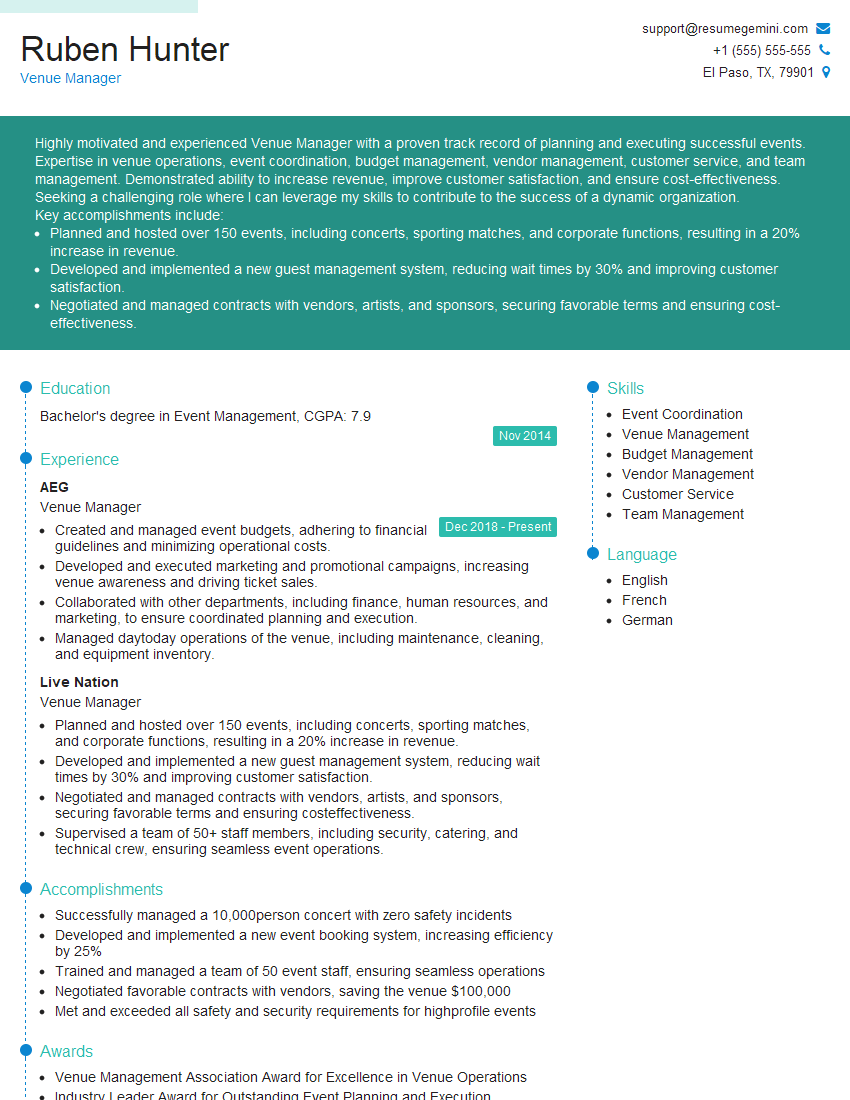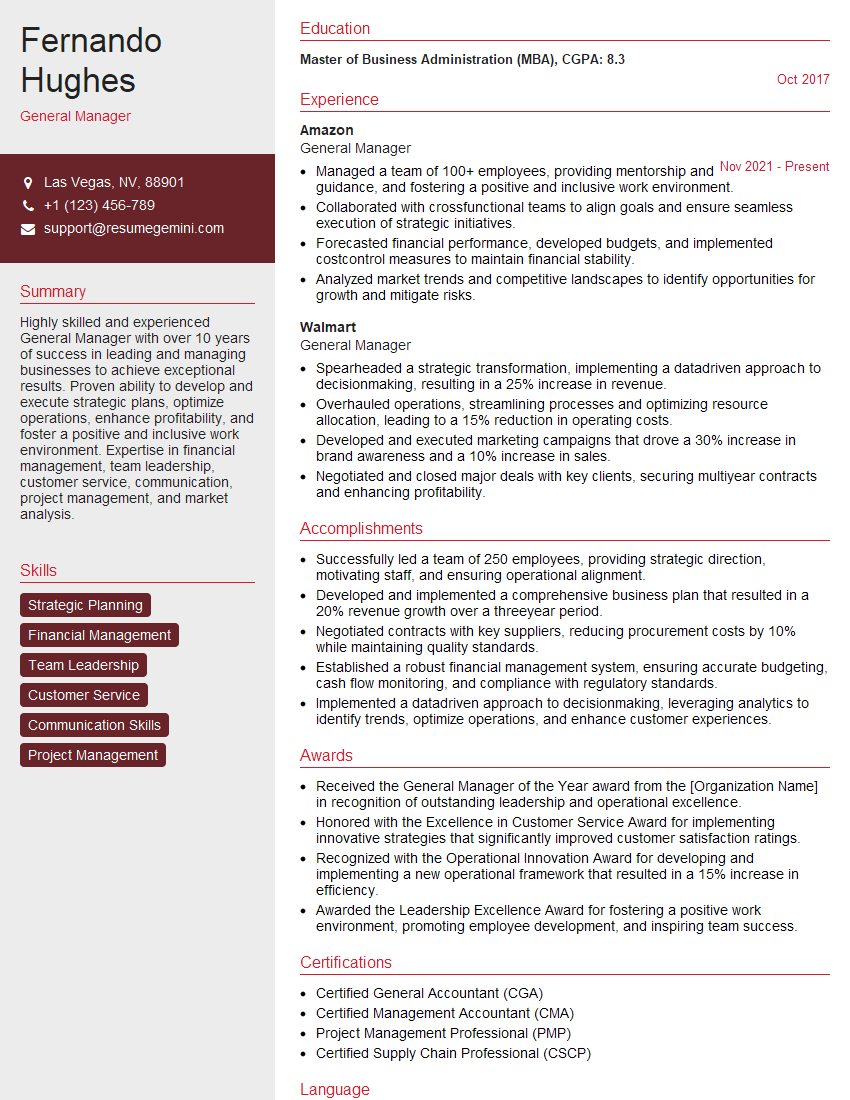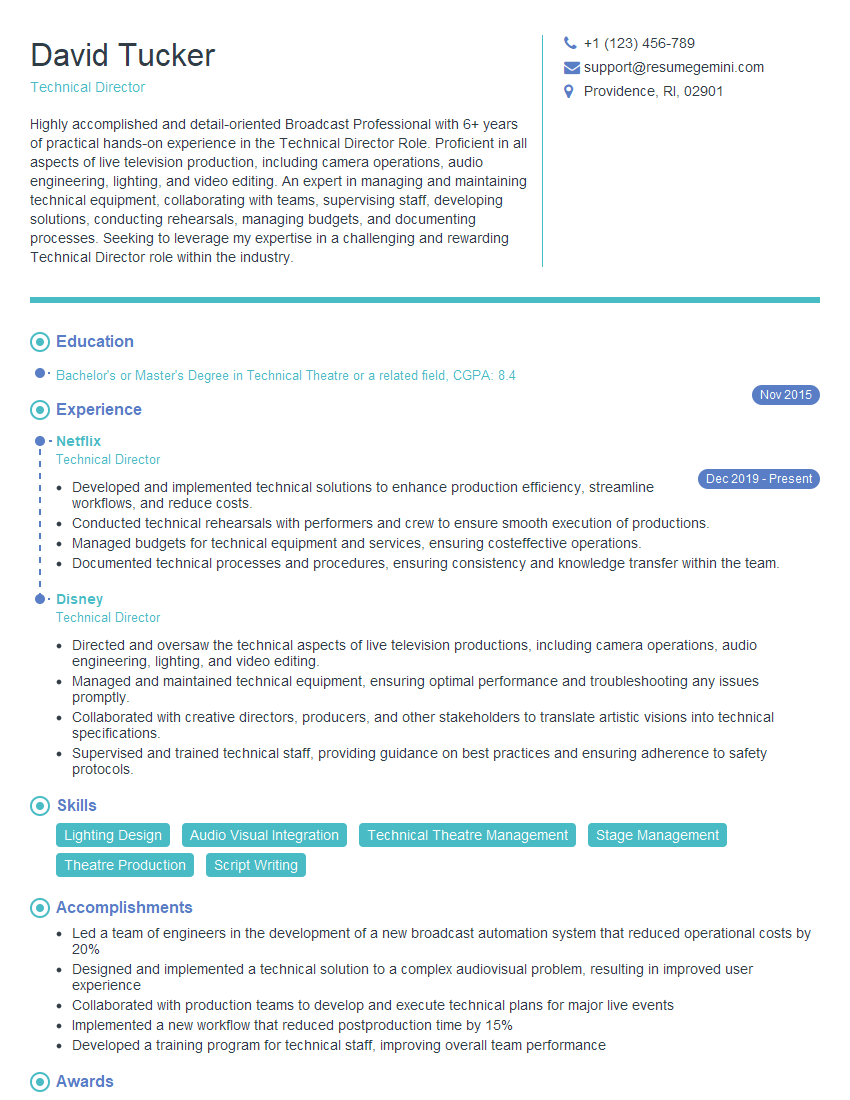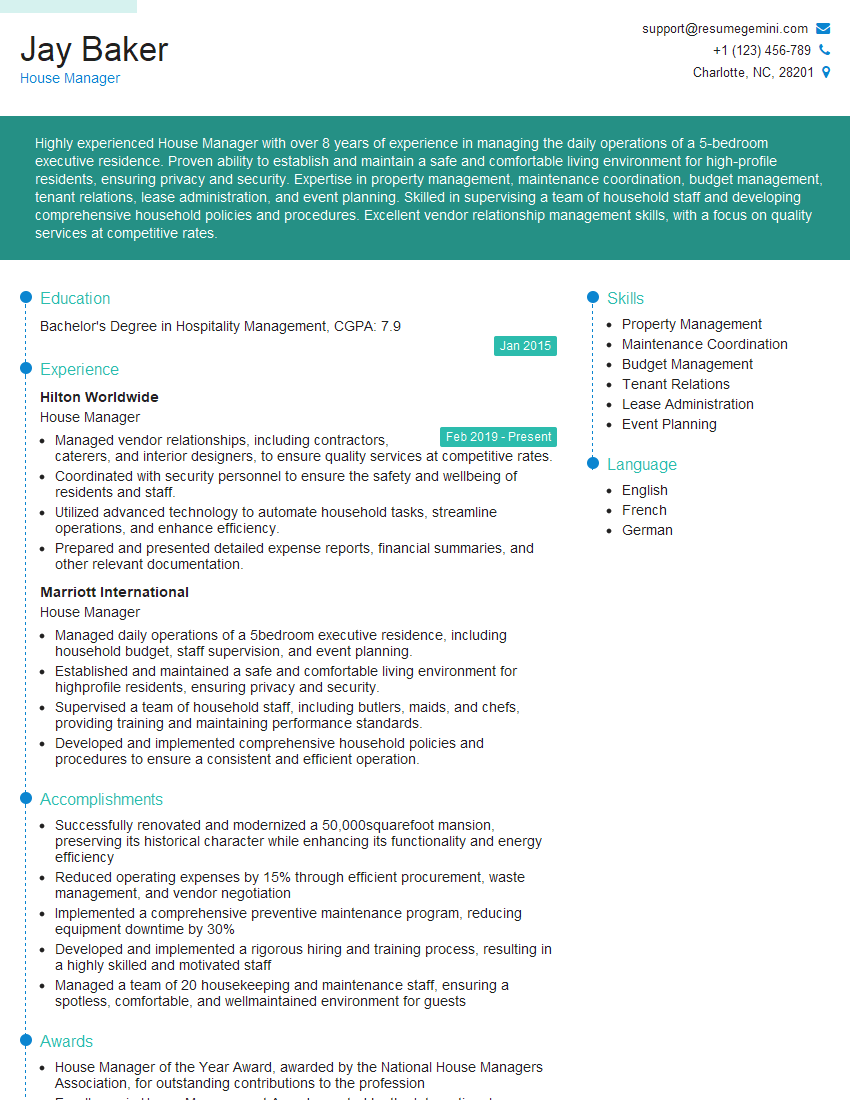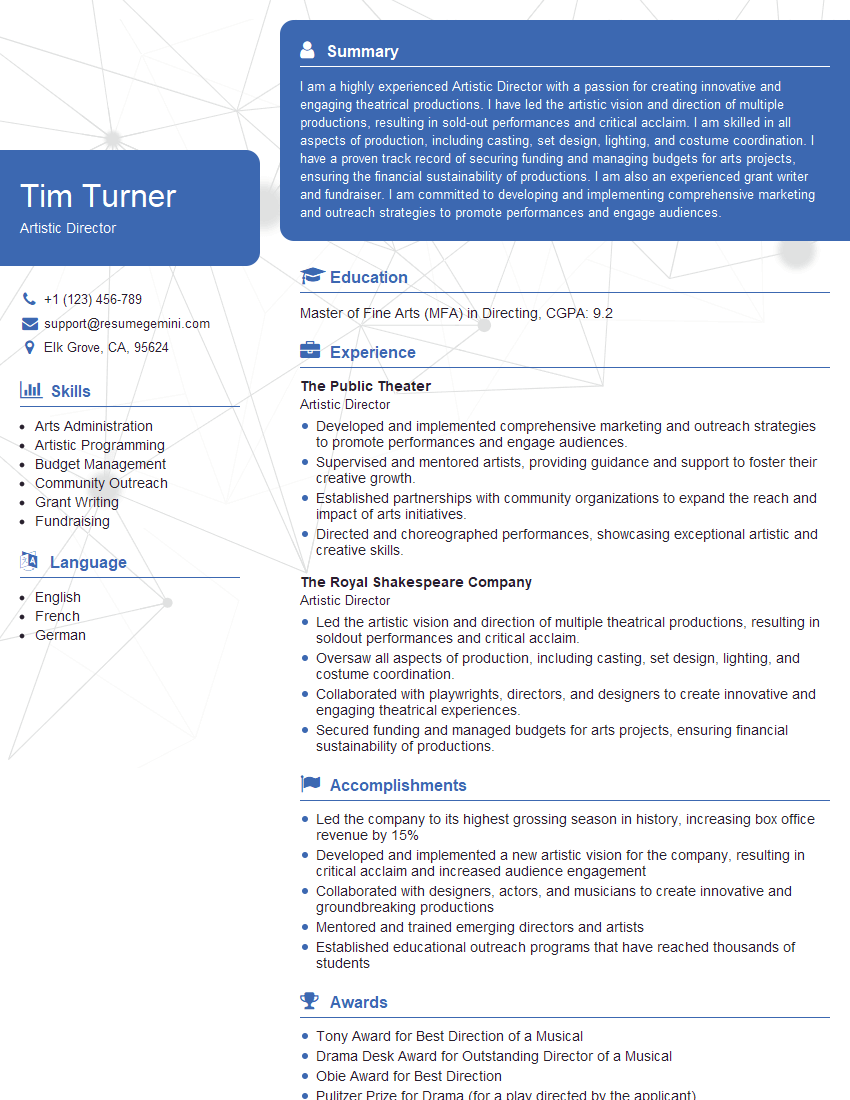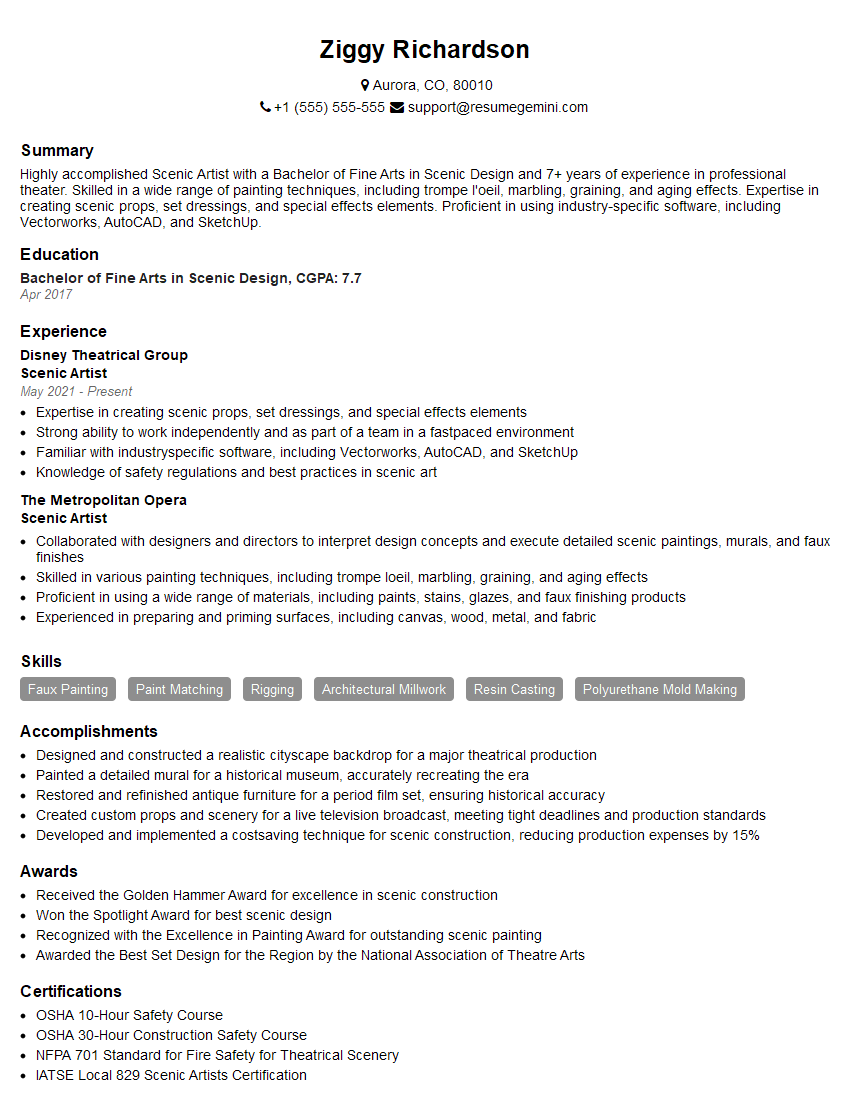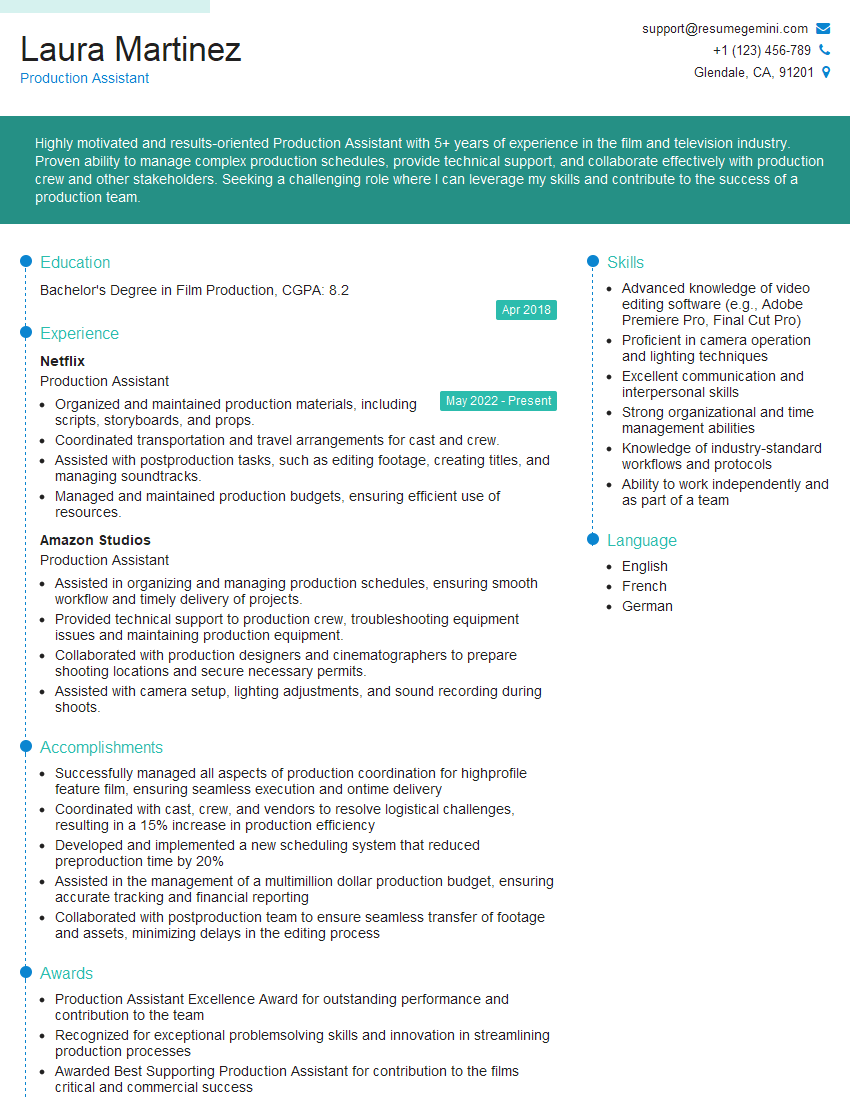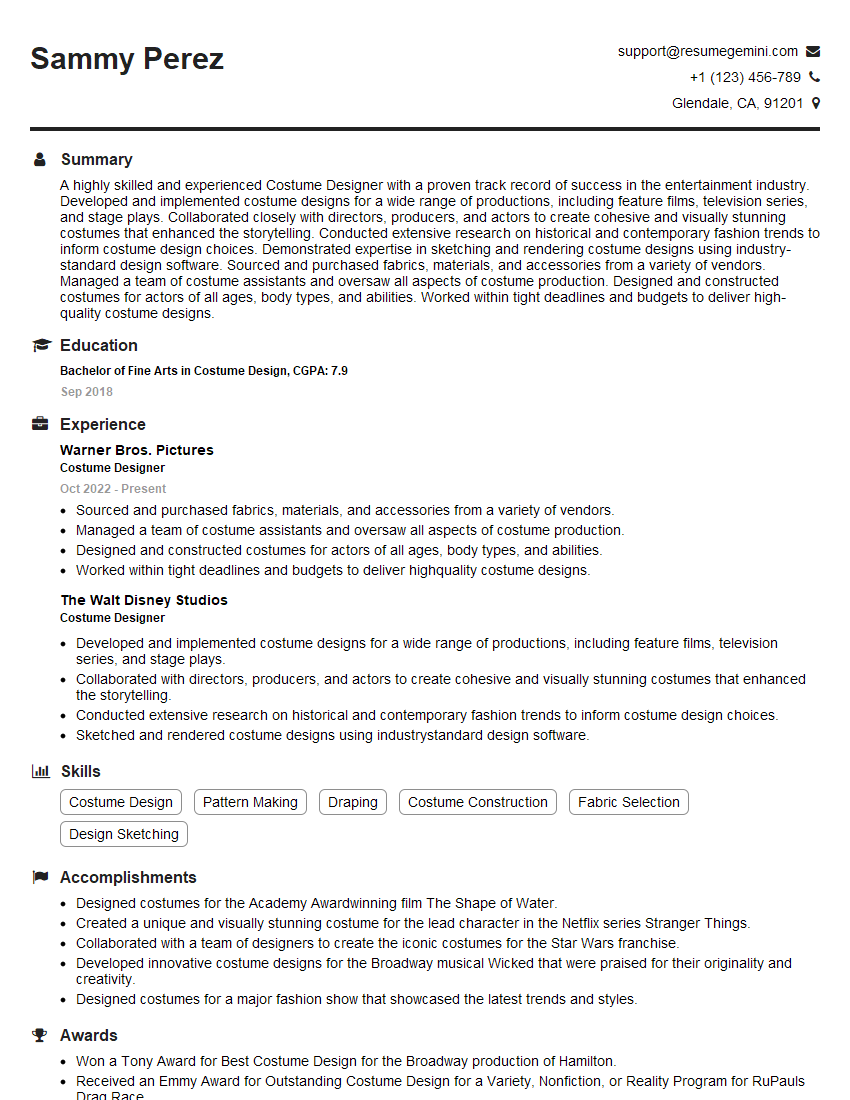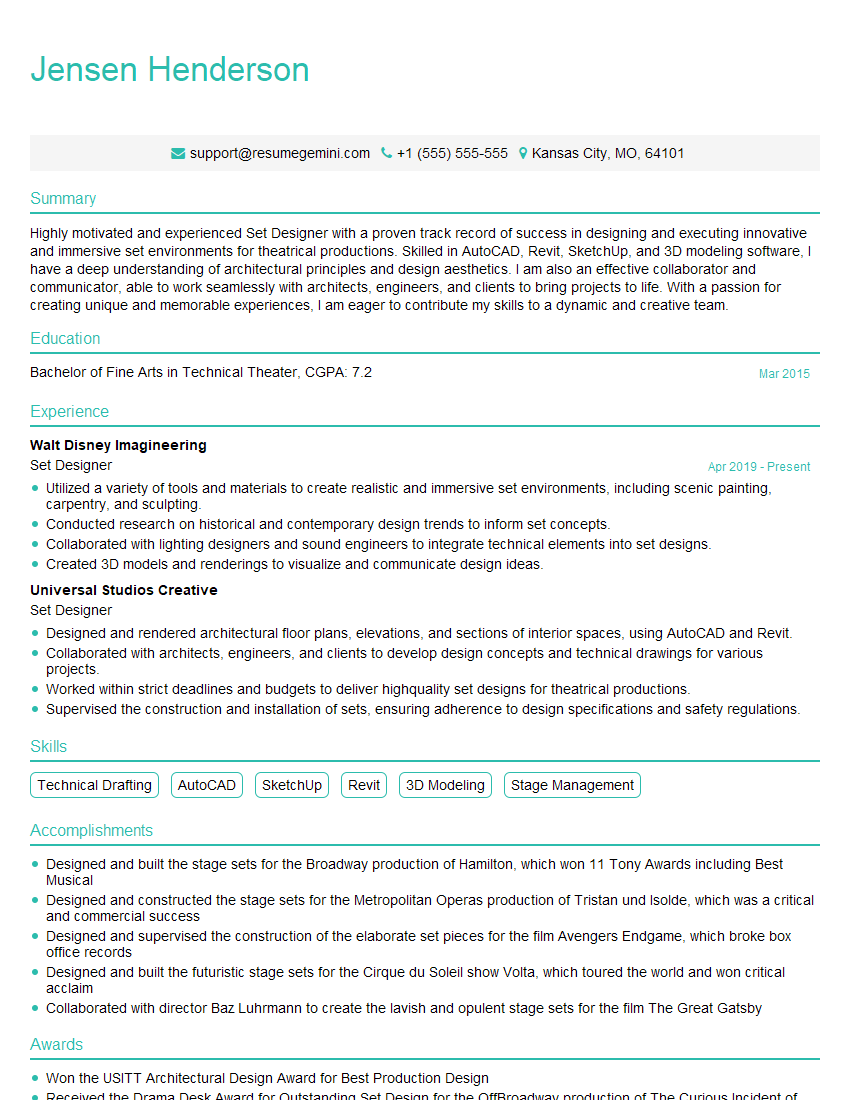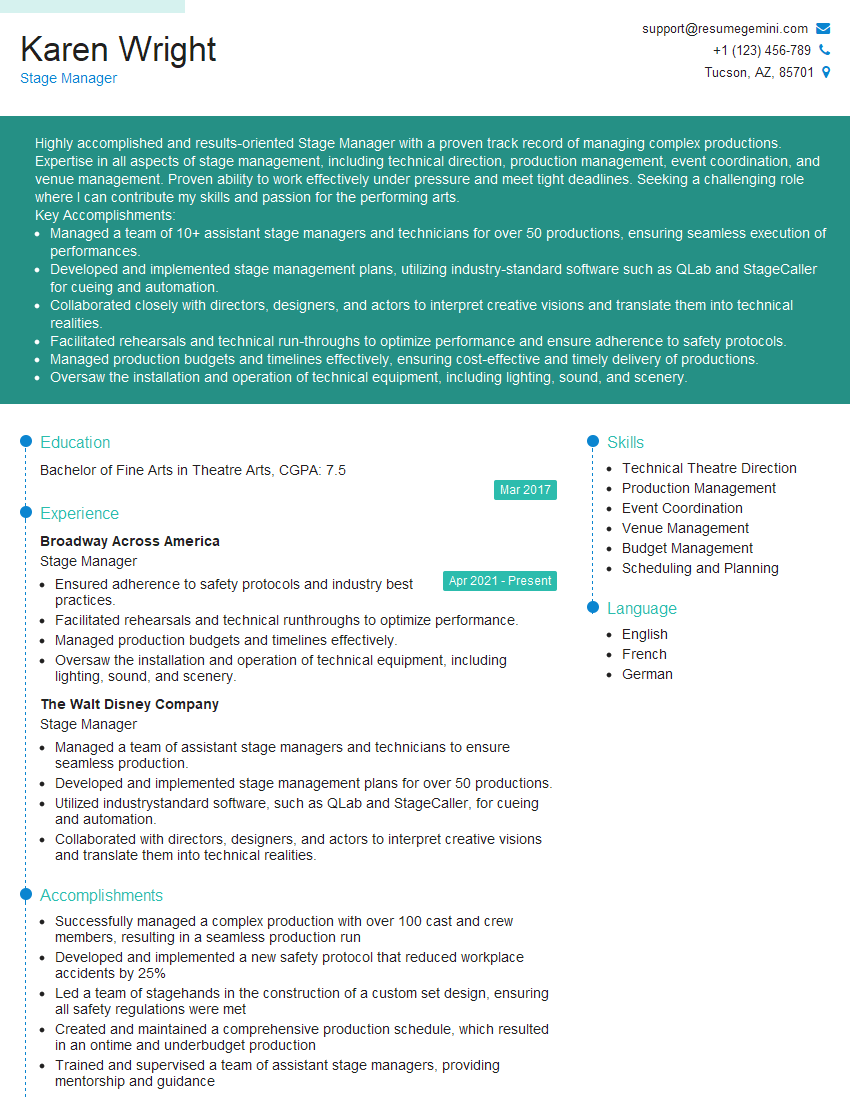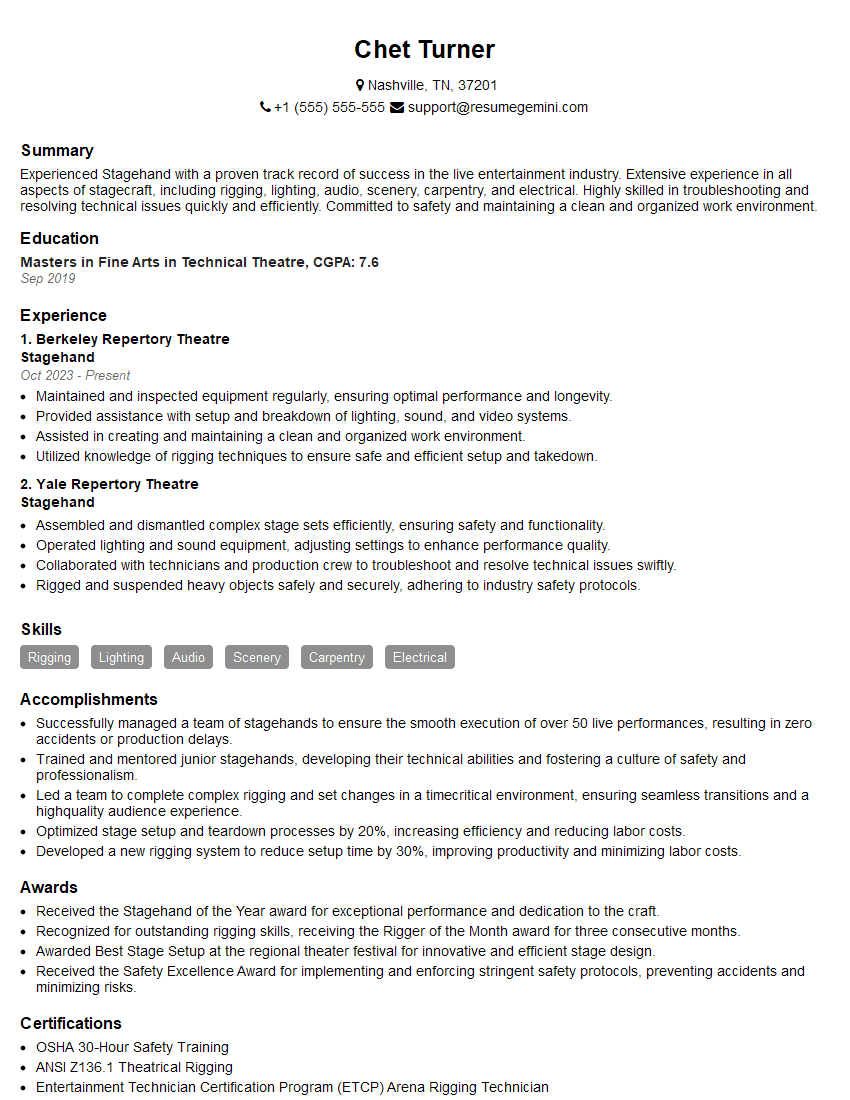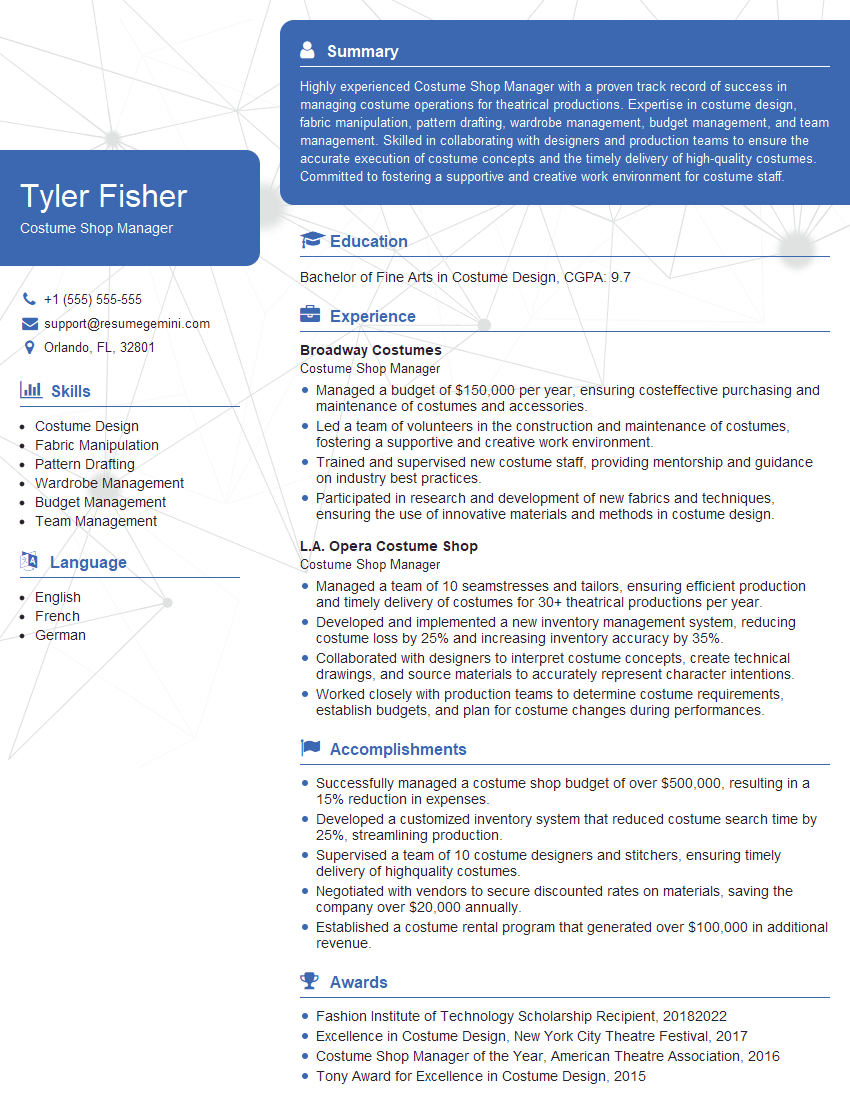Feeling uncertain about what to expect in your upcoming interview? We’ve got you covered! This blog highlights the most important Theater Production and Management interview questions and provides actionable advice to help you stand out as the ideal candidate. Let’s pave the way for your success.
Questions Asked in Theater Production and Management Interview
Q 1. Describe your experience with budgeting and scheduling in a theatrical production.
Budgeting and scheduling are the twin pillars of successful theatre production. A well-crafted budget meticulously outlines every expense – from set construction and costume design to marketing and royalty payments. It’s not just a list of numbers; it’s a strategic document that guides resource allocation and ensures the production stays within financial constraints. Scheduling, on the other hand, dictates the timeline for each stage, from pre-production planning to rehearsals, technical rehearsals, and finally, the run of the show. Both are deeply interconnected; a poorly managed budget can derail the schedule, and vice versa.
In my experience, I utilize spreadsheet software (like Google Sheets or Excel) to create detailed budgets, breaking down costs into categories and using formulas to calculate totals and track expenses. For scheduling, I often employ project management software, such as Asana or Trello, to create visual timelines, assign tasks to team members, set deadlines, and monitor progress. For example, on a recent production of Hamlet, I created a detailed budget forecasting all expenses, and a Gantt chart in Asana to track the progress of set construction, costume creation, rehearsal schedules, and marketing campaigns. Regular budget reviews and schedule adjustments were crucial to keeping the production on track and within budget.
Q 2. Explain your process for managing a team of diverse individuals in a high-pressure environment.
Managing a diverse team in a high-pressure environment requires strong leadership, clear communication, and a collaborative approach. I believe in fostering a culture of respect and inclusivity, where every team member feels valued and heard. This starts with clearly defined roles and responsibilities, ensuring everyone understands their contribution to the overall success of the production. Regular team meetings, both formal and informal, help maintain open communication and address any challenges early on. I find that using a mix of communication methods, from email and project management software to in-person discussions, caters to different communication preferences.
When conflicts arise (which is inevitable in a fast-paced creative environment), I facilitate open dialogue, encourage active listening, and help find solutions that accommodate diverse perspectives. For example, during the production of A Midsummer Night’s Dream, we had a disagreement about the interpretation of a particular scene between the director and the choreographer. Instead of imposing a solution, I organized a facilitated discussion where both parties could express their viewpoints and collaboratively find a compromise that satisfied the creative vision while maintaining artistic integrity.
Q 3. How would you handle a conflict between a designer and a director?
Conflicts between designers and directors are common but often avoidable with proactive management. My approach involves acting as a mediator, not a judge. I start by facilitating a calm and respectful discussion, encouraging each party to clearly articulate their concerns and perspectives. The key is to identify the root cause of the conflict – is it a creative difference, a logistical issue, or a miscommunication? Once the root cause is identified, I work collaboratively with both parties to find mutually agreeable solutions. This might involve compromise, exploring alternative approaches, or clarifying expectations and responsibilities.
For example, on a recent production, the set designer envisioned a complex and expensive set, which conflicted with the director’s vision for a more minimalist design and the budget constraints. By facilitating a conversation and presenting alternative design options that met the artistic vision while remaining cost-effective, we arrived at a solution that satisfied all parties.
Q 4. What software are you proficient in for theatre production and management?
Proficiency in various software is essential for efficient theatre production management. I am highly proficient in spreadsheet software (Google Sheets, Microsoft Excel) for budgeting, scheduling and tracking expenses; project management software (Asana, Trello) for task management, collaboration and timeline creation; CAD software (AutoCAD, Vectorworks) for reviewing set designs and technical drawings; and various graphic design software (Adobe Photoshop, Illustrator, InDesign) for creating marketing materials. My experience also includes using ticketing and CRM software for managing box office sales and audience relationships. This broad software skillset allows me to manage all aspects of a production efficiently and effectively.
Q 5. Describe your experience with risk assessment and safety protocols in a theatrical setting.
Risk assessment and safety protocols are paramount in theatre production, where many potential hazards exist. My process begins with a thorough walkthrough of the venue, identifying potential risks such as trip hazards, fire hazards, electrical hazards, and potential injuries from stage equipment. I then develop a detailed risk assessment document that outlines the potential risks, the likelihood of their occurrence, and the potential severity of the consequences. This informs the development of a comprehensive safety plan that includes preventative measures, emergency procedures, and the designation of safety officers. For instance, ensuring proper rigging techniques, adherence to fire codes, regular equipment inspections, and comprehensive first-aid training for the crew are crucial aspects.
Regular safety briefings for the cast and crew are integral to the safety plan, ensuring everyone understands and adheres to the established protocols. This proactive approach minimizes the risks and creates a safe working environment for everyone involved.
Q 6. How do you ensure smooth communication and collaboration among different production departments?
Smooth communication and collaboration across different production departments (e.g., set design, costume, lighting, sound) are crucial for a successful production. I utilize a multi-pronged approach to ensure seamless communication. Regular production meetings, involving representatives from each department, help keep everyone informed of progress and identify potential conflicts early on. A shared online platform (such as a shared drive or project management software) allows for easy file sharing, ensuring that everyone has access to the most up-to-date information. I also encourage direct communication between relevant departments and facilitate these conversations whenever necessary.
Detailed communication protocols, including clearly defined communication channels and expectations, help prevent miscommunication and ensure that information is disseminated efficiently. For instance, a dedicated email chain for specific departments or the use of a project management tool with built-in communication features, ensures that everyone is always in the loop. This combined approach fosters a collaborative environment where everyone can contribute effectively to the overall success of the production.
Q 7. Explain your method for creating and maintaining a production schedule.
Creating and maintaining a production schedule is an iterative process that begins with a detailed breakdown of the production into distinct phases and tasks. I usually use a Gantt chart or a similar visual representation to track the progress of tasks across various departments. This provides a clear overview of deadlines, dependencies between tasks, and potential bottlenecks. The schedule incorporates buffer time for unforeseen delays, recognizing that theatre production is inherently unpredictable. Regular updates and adjustments are crucial to keep the schedule relevant and accurate throughout the production process.
For example, the schedule for a musical production would include separate timelines for set construction, costume creation, rehearsal schedules, orchestra rehearsals, and marketing activities, with clear milestones and dependencies indicated. Frequent revisions of the schedule based on actual progress and emerging challenges are key to ensuring its effectiveness and managing the production efficiently.
Q 8. How do you prioritize tasks and manage multiple projects simultaneously?
Prioritizing tasks and managing multiple projects in theatre is like conducting an orchestra – each instrument (task) needs attention, but the conductor (me) must ensure harmony. I use a combination of methods. First, I employ a project management system, often a digital tool like Asana or Trello, to break down each project into smaller, manageable tasks. This allows for clear visualization of deadlines and dependencies. Then, I prioritize using a system like the Eisenhower Matrix (urgent/important), focusing on high-impact tasks first. For multiple projects, I create a master schedule, coordinating rehearsals, tech rehearsals, and load-in/load-out dates. Regular progress meetings with team members ensure everyone is aligned and potential roadblocks are identified early. Finally, I embrace flexibility – things rarely go exactly to plan in theatre, and adjusting priorities based on real-time needs is crucial.
For example, during a recent production, we were simultaneously working on set construction, costume fittings, and publicity. Using the project management system, I allocated tasks, set deadlines, and monitored progress. When a set piece was delayed, I adjusted the rehearsal schedule to accommodate, ensuring that other tasks remained on track. This proactive approach prevented major delays and ensured a smooth production.
Q 9. Describe your experience with union contracts and regulations in the theatre industry.
My experience with union contracts (primarily Actors’ Equity Association and IATSE) involves a deep understanding of their respective collective bargaining agreements. This includes knowledge of work rules, pay scales, overtime regulations, and safety protocols. I’ve been directly involved in negotiating riders for specific contracts, ensuring compliance with union regulations throughout all stages of production, from budgeting to payroll. This includes understanding the nuances of different contract types, such as minimum rehearsal time, performance fees, and health and welfare benefits. I’ve managed union calls, handled grievances, and maintained open communication with union representatives. This collaborative approach is crucial for a positive and productive working relationship. Ignoring union regulations can lead to significant legal and financial issues, so meticulous adherence is paramount.
One example involves a situation where a change to the production schedule required an adjustment to actor’s call times. Rather than unilaterally altering the schedule, I actively consulted with the Equity representative to ensure compliance with the contract and to avoid any potential disputes. Open communication prevented delays and maintained a harmonious relationship between the production and the union.
Q 10. What is your experience with various stage management systems and their applications?
I’m proficient in various stage management systems, including traditional methods like prompt books and cue sheets, and contemporary digital tools such as QLab and StageManager. Traditional methods provide a tangible record and allow for quick referencing during performances, especially useful for smaller productions or those with limited technical capabilities. QLab, on the other hand, allows for complex cueing, automation, and sound integration, which is incredibly beneficial in large-scale productions with intricate technical requirements. StageManager, for example, helps manage the entire production schedule and communication between departments. The choice of system depends largely on the specific production needs and budget. My experience extends to effectively using each tool to optimize efficiency, communication, and accuracy.
In a recent production employing QLab, I programmed complex lighting and sound cues, enabling seamless transitions and special effects. The software’s ability to integrate various elements streamlined the technical execution significantly. In another production, the use of a meticulously maintained prompt book was key to managing a quick-change scene, ensuring smooth transitions without significant tech support.
Q 11. How do you handle unexpected technical difficulties during a performance?
Handling unexpected technical difficulties requires a calm and decisive approach, prioritizing safety and minimizing disruption to the performance. My first response is to assess the situation quickly, identifying the problem and its potential impact. Then, I immediately communicate the issue to the relevant technical personnel (lighting, sound, etc.). We follow established protocols and contingency plans. If the problem cannot be resolved quickly, I will work with the stage manager to implement a backup plan, which may involve cutting scenes, adapting dialogue, or making other creative compromises to ensure the show goes on safely. Post-performance, a thorough debriefing helps identify the root cause of the problem and prevents future occurrences.
For example, during a performance, a crucial lighting fixture failed. I immediately alerted the lighting board operator who, using a pre-determined backup cue, swiftly transitioned to a different lighting scheme. The audience didn’t notice the interruption. The subsequent debriefing helped us identify a faulty connection and prevent recurrence.
Q 12. How do you effectively communicate technical requirements to non-technical personnel?
Communicating technical requirements to non-technical personnel requires clear, concise, and visual language. I avoid jargon and technical terms whenever possible. I use analogies and simple explanations to make complex concepts understandable. For example, instead of saying ‘we need to adjust the PAR cans’ to actors, I might say ‘we need to change the intensity of some of the spotlights.’ Visual aids such as diagrams, sketches, or even short videos are invaluable. This ensures everyone is on the same page and understands their responsibilities. Active listening and confirming understanding are crucial to successful communication.
When explaining the need for a specific stage setup to the set crew, I would use a floor plan and explain the positioning of set pieces in relation to actor movements. This visual aid made the instructions clear and easy to understand, resulting in efficient and accurate set construction.
Q 13. What is your approach to problem-solving in a fast-paced production environment?
My approach to problem-solving in a fast-paced production environment involves a systematic approach. First, I clearly define the problem, gathering all relevant information and perspectives. Then, I brainstorm possible solutions, considering the available resources and time constraints. I evaluate the potential risks and benefits of each solution before selecting the most effective one, keeping safety as the top priority. Finally, I implement the solution, monitoring its effectiveness and making adjustments as needed. I emphasize teamwork, encouraging collaboration and open communication to resolve issues efficiently.
For instance, when a crucial prop went missing just before a performance, I quickly assessed the situation, consulted with the prop master, and explored alternative solutions (finding a replacement or improvising). This proactive approach resulted in minimal disruption to the production schedule.
Q 14. Describe your experience with front-of-house operations and audience management.
My experience with front-of-house operations encompasses a wide range of responsibilities, including managing ushers, ticket takers, box office staff, and ensuring smooth audience flow. This involves pre-show preparation, including setting up the lobby, distributing programs, and ensuring clear signage. During the performance, I oversee audience management, addressing any issues or concerns, and ensuring a comfortable and safe environment. Post-show, this includes managing exits and overseeing the cleanup process. My aim is to create a welcoming and efficient experience for the audience, contributing to the overall success of the production.
In one production, we implemented a new ticketing system which initially caused some confusion. Through proactive training and clear communication with front-of-house staff, we efficiently addressed the challenges, ensuring a seamless ticketing process for patrons.
Q 15. Explain your familiarity with different types of theatrical lighting equipment and techniques.
My familiarity with theatrical lighting encompasses a wide range of equipment and techniques, from basic incandescent fixtures to sophisticated LED systems and moving lights. I understand the principles of color mixing (additive and subtractive), the use of gels and filters to achieve specific hues, and the importance of light intensity and direction in shaping mood and focus.
- Incandescent and Halogen Lights: These provide a warm, traditional light, useful for creating intimate settings. However, they generate heat and are less energy-efficient than modern alternatives.
- LED Lighting: Highly versatile and energy-efficient, LEDs offer a wide range of color temperatures and are controllable via DMX (Digital Multiplex) systems. This allows for precise and dynamic lighting changes.
- Moving Lights: These automated fixtures can pan, tilt, and change colors, creating dramatic effects with minimal manual adjustments. They are essential for large-scale productions.
- Fresnels: These lenses create a soft, diffused light, ideal for backlighting or washing large areas of the stage.
- Ellipsoidals (Leko): These produce a sharp, focused beam, perfect for highlighting specific actors or objects. They allow for precise shaping of the light with shutters and gobos (metal templates that create patterns).
My expertise also extends to lighting design principles, including the use of key light, fill light, and back light to sculpt three-dimensionality on stage; the application of color psychology to evoke specific emotions; and the understanding of light plotting and cueing to create seamless transitions and dynamic shifts during a performance. For example, in a recent production of Macbeth, I utilized a combination of deep blues and greens during the witches’ scenes to create an eerie, supernatural atmosphere, contrasting sharply with the warmer tones used in the banquet scene.
Career Expert Tips:
- Ace those interviews! Prepare effectively by reviewing the Top 50 Most Common Interview Questions on ResumeGemini.
- Navigate your job search with confidence! Explore a wide range of Career Tips on ResumeGemini. Learn about common challenges and recommendations to overcome them.
- Craft the perfect resume! Master the Art of Resume Writing with ResumeGemini’s guide. Showcase your unique qualifications and achievements effectively.
- Don’t miss out on holiday savings! Build your dream resume with ResumeGemini’s ATS optimized templates.
Q 16. How do you ensure accurate inventory control of props, costumes, and set pieces?
Accurate inventory control is crucial for smooth production. My approach involves a multi-pronged strategy combining physical inventory checks with a robust digital system. I utilize a dedicated database (often a spreadsheet software or a dedicated inventory management system) to track each item, including its condition, location, and any necessary repairs or replacements.
- Detailed Database: Each prop, costume, and set piece is assigned a unique ID number and logged into the database with a description, images, and notes about its condition.
- Regular Inventory Checks: These are conducted before, during, and after rehearsals and performances to account for all items. Discrepancies are immediately investigated and addressed.
- Designated Storage Areas: Clear labeling and organization of storage spaces streamline the process. Everything has a specific place, preventing loss or damage.
- Check-in/Check-out System: A formal system where crew members sign for items they are using is crucial for accountability.
- Digital Photography/Videography: Documenting the initial condition of items is beneficial for tracking wear and tear and facilitating insurance claims if necessary.
For example, during a recent production, our database alerted us to low stock of specific buttons for a period costume. We were able to order replacements well in advance, avoiding any last-minute delays.
Q 17. Describe your experience with sound system operation and troubleshooting.
I have extensive experience operating and troubleshooting sound systems of varying complexities. My skills range from basic microphone setup and mixer operation to more advanced aspects like digital audio workstations (DAWs) and audio signal processing. I understand sound reinforcement principles, including microphone techniques, equalization, compression, and effects processing.
- Microphone Selection: I choose microphones based on their suitability for different sound sources (e.g., lavalier microphones for actors, dynamic microphones for instruments).
- Mixer Operation: I’m proficient in adjusting levels, equalization, and panning to achieve a balanced and clear mix.
- Troubleshooting: I can identify and fix problems such as feedback, hum, and distortion. This includes identifying faulty equipment, checking wiring, and adjusting settings.
- Sound Effects Integration: I’m comfortable incorporating pre-recorded sound effects and music cues using DAWs, ensuring seamless playback and synchronization.
- System Monitoring: I regularly monitor the sound system during rehearsals and performances to ensure optimal sound quality and identify potential issues proactively.
In one instance, during a live performance, a sudden power surge caused a significant drop in audio output. I swiftly identified the cause by checking the power supply and implemented a backup system, minimizing disruption to the show.
Q 18. How do you handle backstage logistics and movement of actors, crew, and equipment?
Efficient backstage logistics are paramount for a smooth production. My approach emphasizes clear communication, well-defined procedures, and thorough planning. This includes creating detailed stage plots, cue sheets, and communication channels to coordinate the movement of actors, crew, and equipment.
- Stage Plots and Cue Sheets: These visual aids clearly map out the placement of actors, set pieces, and equipment, along with lighting and sound cues.
- Crew Assignments: I assign specific tasks and responsibilities to crew members, ensuring everyone understands their roles.
- Communication Protocols: Clear communication channels (headsets, hand signals, walkie-talkies) ensure quick and effective communication backstage.
- Movement Planning: I design efficient movement patterns for actors and crew to minimize congestion and avoid accidents.
- Emergency Procedures: I establish protocols for handling emergencies, such as injuries or equipment malfunctions.
For example, in a fast-paced scene change, I implemented a color-coded system for set pieces, allowing the crew to quickly identify and move the correct elements, completing the change within the required timeframe without any confusion or delays.
Q 19. Describe your understanding of theatrical design elements and principles.
My understanding of theatrical design encompasses the interplay of various elements to create a cohesive and impactful theatrical experience. This includes set design, costume design, lighting design, sound design, and their integration to support the narrative and thematic elements of a production.
- Set Design: Understanding principles of scale, proportion, line, shape, color, and texture in creating functional and aesthetically pleasing sets.
- Costume Design: Appreciating the role of costumes in establishing character, period, and mood.
- Lighting Design: Knowledge of the use of light to shape mood, highlight actors, and create visual effects.
- Sound Design: Understanding the use of sound to enhance the atmosphere, create transitions, and underscore emotional impact.
- Composition and Visual Storytelling: The ability to analyze and understand how different design elements work together to tell a visual story.
For instance, I recently worked on a production where the set design was minimalist, utilizing mostly symbolic props. This allowed us to focus on lighting effects to create various moods and spaces throughout the play, demonstrating my understanding of how different elements can complement each other effectively.
Q 20. How do you collaborate effectively with designers to realize their creative visions?
Collaboration is key to realizing a designer’s vision. My approach involves open communication, active listening, and a commitment to understanding the artistic intent. I proactively facilitate discussions, share practical insights, and help overcome technical challenges. This ensures the design concepts translate seamlessly from the drawing board to the stage.
- Regular Meetings: I schedule regular meetings with designers to discuss progress, address concerns, and ensure alignment on goals.
- Active Listening: I carefully listen to designers’ ideas and ask clarifying questions to ensure a thorough understanding.
- Technical Expertise: I share my technical expertise to guide designers in making realistic and achievable choices. This includes offering suggestions on material selection, construction techniques, and lighting solutions.
- Problem-Solving: I actively participate in brainstorming solutions for technical challenges, adapting the design where needed while respecting the creative vision.
- Respectful Feedback: I provide constructive feedback in a positive and supportive manner.
For example, in a recent collaboration with a costume designer, their initial vision required intricate hand-stitching for a specific garment that wasn’t feasible within the given time and budget. Through open discussion, we explored alternatives that maintained the design aesthetic while using more efficient techniques.
Q 21. What experience do you have with pre-production, rehearsal, and post-production processes?
My experience spans the entire theatrical production process, from pre-production planning to post-production analysis. I understand the unique demands of each phase and contribute effectively to each stage.
- Pre-Production: This phase involves detailed budgeting, scheduling, and sourcing of materials. It also includes creating detailed plans and documents for set construction, costume creation, and technical aspects. I participate in initial design meetings and contribute to practical decisions.
- Rehearsal: During rehearsals, I provide technical support, ensure the smooth running of equipment, and work closely with the director and designers to refine the staging and technical elements. I am actively involved in lighting and sound cueing.
- Post-Production: After the show closes, I am involved in striking the set, returning costumes and props, and reviewing the production to identify areas for improvement in future productions. I document any challenges or successes to inform future projects.
For example, in one recent production, during pre-production, we identified a potential budget overrun. Through careful negotiation with vendors and exploring cost-effective alternatives without compromising quality, we managed to stay within budget. In post-production, we analyzed audience feedback and technical logs to refine our processes for future similar productions.
Q 22. Describe your experience with running a technical rehearsal and resolving technical issues.
Running a technical rehearsal is like conducting a highly orchestrated symphony. It involves meticulously testing all the technical elements – lighting, sound, set changes, projections – to ensure seamless integration with the actors’ performance. My approach begins with a detailed run-through of the show, meticulously noting any technical glitches or timing issues. For example, during a recent production of Hamlet, we discovered a lighting cue was delayed by two seconds, disrupting the actor’s emotional delivery during a key monologue.
Resolving technical issues requires a calm, methodical approach. We use a collaborative problem-solving process involving the lighting designer, sound engineer, stage manager, and myself. We’ll analyze the issue, brainstorm solutions, and prioritize fixes based on their impact on the performance. In the Hamlet instance, we quickly adjusted the lighting cue timing in the control console, and the issue was solved in under 10 minutes. This often involves a combination of adjusting equipment settings, coordinating crew actions, and improvising solutions if necessary. Documenting these fixes is crucial to prevent recurrence, which we do using a detailed production report.
Q 23. Explain your understanding of the importance of health and safety regulations in the theatre.
Health and safety regulations in theatre are paramount; they aren’t just rules, but a crucial part of ethical and responsible production. A single lapse can lead to serious injury or even fatality. My understanding encompasses all aspects, from risk assessments before the show begins to emergency procedures. This includes ensuring proper fire exits are clearly marked and accessible, that all equipment is used according to manufacturer specifications, that actors are aware of potential hazards (such as set pieces that might be unstable), and that the work environment is consistently safe from potential hazards.
We use regular safety briefings and training sessions to ensure everyone on the team is aware of their responsibilities. We also make sure that proper PPE (Personal Protective Equipment) is readily available and used where needed, such as for working at heights or handling potentially hazardous materials. Regular inspections of equipment and the venue are also a part of my routine. Think of it like this: our primary concern before the artistic aspects of the show is everyone’s well-being, because you cannot have a successful production without a safe and healthy team.
Q 24. How do you conduct a load-in and load-out efficiently and safely?
Efficient and safe load-in and load-out are critical for timely production and preventing accidents. My strategy emphasizes meticulous planning and clear communication. This begins with a detailed inventory list of all equipment and scenery, a pre-determined loading plan considering the venue’s specifications, and a well-trained team briefed on their individual roles and responsibilities.
Before the load-in, we coordinate with the venue to ensure proper access to loading docks and storage areas. We utilize appropriate lifting equipment and ensure everyone understands safe lifting techniques, implementing ‘spotters’ to guide heavy loads. During the process, I oversee the placement of all equipment and scenery, ensuring that it complies with both safety regulations and the production design. Load-out follows a similar process in reverse. Equipment is systematically removed, packaged, and loaded, again adhering strictly to safety protocol. Clear communication throughout both processes is paramount to ensure the smooth and efficient movement of materials and people.
Q 25. What are your methods for ensuring the quality and accuracy of production documentation?
Accurate and comprehensive production documentation is the backbone of a successful theatre production. It serves as a central reference point for all team members and ensures continuity throughout the process. My approach involves establishing a system for tracking and storing all relevant documents in a centralized location, usually a shared digital drive or cloud-based system. This includes detailed scene descriptions, lighting plots, sound cues, prop lists, costume designs, stage management notes, and risk assessments.
We utilize version control to manage document revisions, ensuring that everyone is working from the most up-to-date versions. Regular reviews of these documents, perhaps during team meetings, ensure accuracy and identify any inconsistencies. Clear labelling, consistent formatting, and detailed descriptions are essential aspects of our documentation strategy. For instance, all lighting cues will include not only their timing but also the specific instruments used and their intensity levels. By maintaining a standardized and meticulously accurate documentation system, we prevent costly errors, ensure consistent interpretation of design elements, and make production handoffs between crew members much easier.
Q 26. How do you handle last-minute changes or adjustments to a production schedule?
Last-minute changes are inevitable in theatre. My response involves calm prioritization and clear communication. Firstly, I assess the impact of the change: is it a minor adjustment or a major alteration requiring significant reworking? Then, I collaborate with the relevant team members – directors, designers, stage managers – to determine the most efficient solution that minimizes disruption to the overall schedule. This might involve re-allocating resources, adjusting rehearsal schedules, or adapting the production design.
For example, if an actor falls ill and an understudy needs to step in, we quickly coordinate with the understudy and stage manager to update the blocking and ensure all cues work smoothly with the replacement actor. Open and transparent communication, including prompt notification to all affected team members and regular updates on the progress of the adaptations, is key. Flexibility, adaptability, and a proactive approach are vital for successfully handling these situations while maintaining a positive team environment. The goal is to minimize stress and ensure a quality performance despite the unexpected changes.
Q 27. Describe your experience working with different types of performance spaces (proscenium, thrust, black box, etc.)
I have extensive experience working with various performance spaces – proscenium, thrust, black box, and arena staging. Each space presents unique challenges and opportunities. A proscenium stage, with its traditional audience configuration, allows for elaborate set designs and complex lighting schemes. A thrust stage, extending into the audience, requires more careful consideration of actor movement and sightlines. Black box theatres offer maximum flexibility but often demand creative solutions due to their limited resources. Arena staging, with the audience surrounding the performance area, poses significant challenges in terms of set design and sightlines, demanding a highly mobile and adaptable staging approach.
My adaptation strategies involve careful study of the venue’s specifications – dimensions, technical capabilities, rigging points, etc. – before starting the production design process. This understanding informs both set design and technical planning. For example, a proscenium stage might allow for flying scenery, while a black box theatre will rely more on simpler, easily manipulated stage mechanisms. The process involves careful planning for sightlines, access points, and technical limitations. Each space demands a unique approach to design and production, and my experience across a variety of venues allows me to adapt quickly and efficiently.
Q 28. What are your strategies for creating a positive and productive work environment for a production team?
Creating a positive and productive work environment is essential for a successful production. I believe this starts with clear and respectful communication. I maintain open communication lines, using regular team meetings and informal check-ins to foster collaboration and address concerns promptly. I also focus on recognizing and celebrating team achievements, fostering a sense of collective accomplishment.
Fairness and equity in workload distribution, providing opportunities for team members to utilize their skills and contribute meaningfully, are key aspects of this approach. Providing clear roles and responsibilities from the beginning eliminates ambiguity and confusion. Addressing issues promptly and directly, and providing constructive feedback and support, builds a supportive and productive team dynamic. Respecting individual work styles and providing a safe space for creativity and innovation helps cultivate a positive team atmosphere. A positive work environment isn’t simply a perk; it is a critical component of a successful and fulfilling production.
Key Topics to Learn for Theater Production and Management Interview
- Production Planning & Budgeting: Understanding the process of creating detailed budgets, scheduling rehearsals and performances, and managing resources effectively. Practical application includes developing a realistic budget for a small-scale production and outlining a performance schedule.
- Crew Management & Communication: Successfully leading and collaborating with diverse teams, including designers, technicians, and actors. This involves clear communication, conflict resolution, and delegating tasks effectively. Consider how you’d handle a last-minute technical issue or a conflict between crew members.
- Technical Theater & Stagecraft: Demonstrate a foundational understanding of lighting, sound, set design, and stage management. Practical application could involve discussing your experience with specific technical elements or describing how you’d troubleshoot a lighting malfunction.
- Marketing & Promotion: Understanding strategies for promoting theatrical productions, including digital marketing, publicity, and audience engagement. Think about creative ways to reach target audiences and build excitement for a show.
- Contract Negotiation & Legal Aspects: Familiarity with industry standard contracts, rights and permissions, and the legal framework surrounding theatrical productions. Consider how you would handle a contract dispute or ensure compliance with relevant regulations.
- Risk Management & Safety Protocols: Implementing safety procedures for actors, crew, and audiences. This includes addressing potential hazards and ensuring compliance with relevant safety regulations.
Next Steps
Mastering Theater Production and Management opens doors to diverse and rewarding career paths, from running your own company to working in prestigious theaters worldwide. To maximize your job prospects, creating a strong, ATS-friendly resume is crucial. ResumeGemini is a trusted resource that can help you craft a professional and impactful resume tailored to highlight your unique skills and experience. We provide examples of resumes specifically designed for Theater Production and Management professionals to help you get started. Invest the time to build a compelling resume – it’s your first impression on potential employers.
Explore more articles
Users Rating of Our Blogs
Share Your Experience
We value your feedback! Please rate our content and share your thoughts (optional).
What Readers Say About Our Blog
Hello,
We found issues with your domain’s email setup that may be sending your messages to spam or blocking them completely. InboxShield Mini shows you how to fix it in minutes — no tech skills required.
Scan your domain now for details: https://inboxshield-mini.com/
— Adam @ InboxShield Mini
Reply STOP to unsubscribe
Hi, are you owner of interviewgemini.com? What if I told you I could help you find extra time in your schedule, reconnect with leads you didn’t even realize you missed, and bring in more “I want to work with you” conversations, without increasing your ad spend or hiring a full-time employee?
All with a flexible, budget-friendly service that could easily pay for itself. Sounds good?
Would it be nice to jump on a quick 10-minute call so I can show you exactly how we make this work?
Best,
Hapei
Marketing Director
Hey, I know you’re the owner of interviewgemini.com. I’ll be quick.
Fundraising for your business is tough and time-consuming. We make it easier by guaranteeing two private investor meetings each month, for six months. No demos, no pitch events – just direct introductions to active investors matched to your startup.
If youR17;re raising, this could help you build real momentum. Want me to send more info?
Hi, I represent an SEO company that specialises in getting you AI citations and higher rankings on Google. I’d like to offer you a 100% free SEO audit for your website. Would you be interested?
Hi, I represent an SEO company that specialises in getting you AI citations and higher rankings on Google. I’d like to offer you a 100% free SEO audit for your website. Would you be interested?
good


